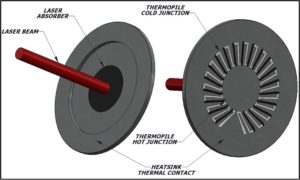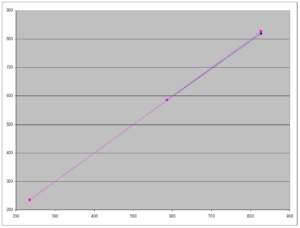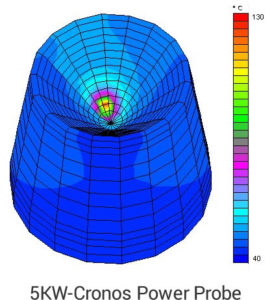Thermopile technology for thermal sensors for Laser Power and Energy measurement.
Thermal methods of measuring power and energy are those in which radiant energy is absorbed and converted into heat, which generates a temperature rise in the absorber. The absorbed energy is then measured through a function that takes into account the temperature gradient between the hot area (where the laser strikes) and a cool area (where the generate heat is dissipated). This measurement can be done by means of thermocouples arrays (thermopile). The temperature difference will generate a voltage at the end of each single thermocouple and, if the array is duly distributed over the sensor’s surface, the resulting total voltage will be proportional to the incident power or energy.
A strong advantage of this approach is that there is no influence on the measurement from ambient temperature variations because the generated voltage depends on the temperature difference between the hot and the cold areas.
To dissipate the generated heat, a thermal sensor must be placed within a housing which, depending on the amount of heat to be driven away, can dissipate by simple convection, have electrical low voltage fans or can be water cooled.
The final shape and dimensions of the heads must be carefully designed to maintain the sensor temperature within its working limits.
Thermal detectors also have an intrinsic high degree of linear response at the increase of power levels (linearity); a compensation for those minor drops in linearity that occur at the working extremes are, in general, made by using thermistors.
Linearity of LaserPoint’s detectors, thanks to their optimised thermal design, is excellent: the picture shows linearity of a non-compensated air cooled 600W head (Mod A-600-D60-HPB) working up to 850 W, compared against a NIST reference. It show only a 3% drop at the extreme values, far above specifications.
Another strong point in favour of thermal detectors is their almost non-dependence from laser beam size and position. In fact, since the generated heat all flows through the thermocouples, whether they are deposited on circles (radial thermopiles) or linearly, with the hot and cold areas facing each other (axial thermopiles) the total signal (laser power) is given by the sum of contributions from all thermocouples.
The response time is determined by the thermal resistances, by the thermal capacities and, mostly, by the geometrical sizes of the sensor disks. The intrinsic response times of detectors are significantly reduced by appropriate acceleration algorithms with Laser Point’s meters.




